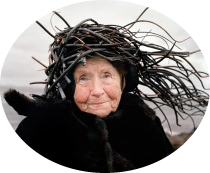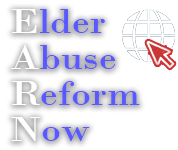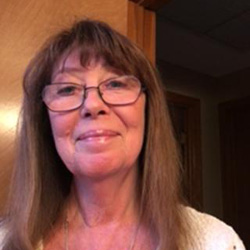You Have The Time

You Can Make the Difference
Changing a Child's Life (In Other Words, How to Be the Pie Lady)
By Leah Grace Goodwin
In the movie The Shack (based on a novel of the same name by William Paul Young), a painful early scene unfolds: The main character, Mackenzie, in this scene a young boy, witnesses his father unhinged by an alcohol-induced rage. He watches, frozen in horrified fear, as his father beats his mother unconscious. Mack then endures a brutal belt whipping at the man’s hands after confessing to another person his father’s bouts of madness. The child is anguished that he stood by and watched his mother being abused—anguished despite the fact that he is a little boy.
Mack limps off down the street, passing by a house on the corner. An older woman (played by Octavia Spencer) comes out on the porch.
“Mack!” she calls. “I just took an apple pie out of the oven. Come have a slice.”
Mack demurs. “No, thanks.”“That wasn't a question,” she points out calmly. “Here you go.”
She sits on the porch steps with him. Somehow, she knows precisely what is going on in Mack’s house—or, at least, that Mack suffers.
“Look at me, baby,” she says gently. “Daddies aren't supposed to do that to their kids. It ain't love. You understand?
Mack does indeed understand, and he grows up to be the gentlest of fathers. At the same time, though, the Pie Lady’s words reveal to him a glimpse of a world in which love is not erratic, demanding constant strategic assessment to avoid torment—a world in which love involves consistent care, healthy boundaries, teamwork, and patience.
As a parent myself, I can confidently say that no parent is perfect, and every parent has his or her own strengths and weaknesses—or, removing assessment language, you could call it a “parenting style.”
That said, many children in this world effectively grow up without parents—parents who are distracted by substance use or domestic violence or homelessness, for example. That’s hard enough for a child, who is in the process of learning how to relate to other people and form bonds and learn trust. Even worse, many children grow up, like Mack, in torment. These little ones learn to walk on eggshells around abusive adults (not that the strategy necessarily works, mind you). These little ones’ minds whirl constantly in fear. These little ones witness and suffer horrific acts. These little ones learn to lie and steal to protect themselves.
All of the above are adaptive behaviors—behaviors designed instinctively for survival. We may be born hardwired with particular personality traits, but our environment shapes us enormously—especially in childhood, when our brains are learning what “normal” and “right/wrong” mean. Adaptive behaviors are not necessarily “good” behaviors—they’re just what get us through the day, through life.
But, as e. e. cummings said, “here is the root of the root and the bud of the bud”: These little ones do not learn their own worth. They do not learn about a realm in which they are trusted, held accountable fairly, cared for, or treated tenderly. They do not learn what a joyful, or even functional, life looks like. The concept is simply outside their imagination. Consequently, their adaptive behaviors can become destructive.
In short, generationally speaking, bedlam begets bedlam. Without outside help, the cycle of misery, as I mentioned in last issue’s column, continues.
As the scene from The Shack reveals, though, it doesn’t have to be this way. Mack does break the cycle of violence and becomes a wonderful husband, father, and friend. Why? Because the Pie Lady on the corner takes him under her wing, shows him care and love, feeds him, pierces his protective emotional armor. Because she tells him something about love that perhaps he didn’t know before.
You can be the Pie Lady (who, spoiler alert, turns out later in the movie actually to be one of the face of the divine). You can help break that cycle of sadness. As a senior, your life experience—and your consistent attention and care—can change the shape of a child’s entire existence. What a gift, to transform a life, and in so doing, potentially transform generations of lives! By offering your time and showing how your life works—how you act in various situations, how others treat you and you treat others—you can bend the “arc of the moral universe” toward functional behavior and kindness.1
But this act of mercy isn’t just a matter of taking an abused or neglected or simply unhappy child to special events. Getting ice cream together or making a sandwich or having a chat on the porch steps is a wonderful thing and a great part of an intergenerational relationship, but that in itself isn’t going to change the world for a little one in hardship. Changing a kid’s life means changing their outlook and actions. It means absorbing them, to the degree possible, into your own life, so that they can actually imagine life beyond the sorrow or silence or horror of their current world.
Here’s an example: Before the Kibbee’s Kids foundation was dismantled by bad actors via corrupt guardianship, its leadership had taken a wonderful, but often behaviorally difficult, group of children under its wings. One of the premises of the foundation was to introduce the concept of positive, rather than negative, reinforcement. So, if a child did something particularly wonderful—something extremely kind or honest or demonstrating consistent effort or the like—that child received a “prize” of his or her choosing.
One very abused little girl, Jenny,2 did something extraordinary and was due her positive reinforcement, her prize. She desperately wanted pink cowboy boots (remember, the Kibbee’s Kids headquarters was in Wyoming, cowboy country). So one of the women in the leadership drove Jenny to a premier saddlery in the area’s nearby city. This particular saddlery is a very exclusive store—not the kind of place that Jenny would ever have dreamed of entering (and if she had, sadly, the kind of place where she would have been closely watched for fear of shoplifting). Jenny, before Kibbee’s Kids, simply would not have fit the saddlery’s elite customer profile.
But the saddlery knew of the foundation and supported its mission. And, of course, the woman shepherding her fit precisely their customer demographic; she could blithely walk through their doors and articulate what she wanted and receive polite and attentive service. This woman’s experience of the world was utterly different from Jenny’s.
In that trip to the saddlery, she opened Jenny’s young eyes to that world. Jenny learned what good treatment looks like, not only from her chaperone but from strangers in a public setting. No one followed Jenny suspiciously around the store. No one ignored her. No one told her to leave. The door cracked open to an entirely new universe.
“Who,” said the salespeople, “is this pretty little girl? And what can we do for you today?”
Six tried-on—all price-tag-free and extremely expensive—pairs of pink cowboy boots later, Jenny had chosen her prize.
The rather extraordinary expense wasn’t the point, and Jenny never heard a word about it. The point was that Jenny earned something, learned that it was okay to express her particular desire for the promised reward, got that reward, and received good treatment.
Yes, it was a special trip, a particular outing. But the most important point of the experience was that Jenny learned what her mentor’s world was like. In her mentor’s world, you see, people were polite to her. They acknowledged her. They listened to her. They did everything in their power to respond to her request. Jenny never had to wheedle or shoplift or cower or negotiate or watch unpleasant interactions to receive attention.
Jenny’s mentor also made a point of showing her trust in the little girl and the other Kibbee’s Kids, despite the possibility of the above-mentioned behaviors that so many abused kids develop—stealing, lying, and the like. She left her purse next to Jenny and the other kids and didn’t remove her wallet. She left change lying openly out in the car or on the counter. She showed her faith in Jenny’s and the other kids’ inherent goodness, in their ability to learn new behaviors as a result of living in a realm where they were valued and treated consistently kindly.
So how to go about absorbing a child into your world?
I offered some suggestions in last issue’s column, but here’s another idea: Become a court-appointed special advocate for a child.
Court Appointed Special Advocates for Children (CASA) states the following as its mission:
The National Court Appointed Special Advocate Association, together with its state and local member programs, supports and promotes court-appointed volunteer advocacy so every abused or neglected child in the United States can be safe, have a permanent home, and [enjoy] the opportunity to thrive.
How does being a court-appointed special advocate (or guardian ad litem) work? According to the site,
CASA/GAL volunteers are appointed by judges to watch over and advocate for abused and neglected children, to make sure they don’t get lost in the overburdened legal and social service system or languish in inappropriate group or foster homes. Volunteers stay with each case until it is closed and the child is placed in a safe, permanent home. For many abused children, their CASA/GAL volunteer will be the one constant adult presence in their lives [until adoption]. Independent research has demonstrated that children with a CASA/GAL volunteer are substantially less likely to spend time in long-term foster care and less likely to reenter care.3
86,995 CASA volunteers change kids’ lives for the better every day. Meanwhile, 432,677 children are waiting for a volunteer empowered to find them a safe, loving, permanent home. CASA needs you!
Abused and neglected children face powerful influences of darkness. You, as a senior, have what it takes to counteract those forces. You have the internal resources to change the shape of the future, one young person at a time. Whether your childhood was blessedly golden, or you had a mentor, or you yourself somehow overcame negative influences to develop into a person of character, you can be the Pie Lady who changed Mack’s life. You can show a kid that life may be messy, but it needn’t be bedlam. You can open the door, or slide up a window, into a new life, a life that is not sly and fearful and vicious but joyful and brave and communicative.
Think, please, on that idea: As a senior, you are uniquely powerful. You are uniquely able. You are uniquely wise. You are uniquely gifted. Whether as a CASA volunteer or through another organization, you have the opportunity to change a life, and then some.
And guess what? It’s mutual. That child’s and their children’s lives won’t be the only ones rebuilt for the better. Yours will be, too. Love is a two-way street.
















 Are Preserved by Uncomfortable Conversations
Are Preserved by Uncomfortable Conversations What do you do when you discover your beloved grandmother has been scammed by guardianship deception? If you’re Elaine Renoire, you not only fight to protect your aged relative, you start a national organization to protect the rights of others, so it never happens to another.
What do you do when you discover your beloved grandmother has been scammed by guardianship deception? If you’re Elaine Renoire, you not only fight to protect your aged relative, you start a national organization to protect the rights of others, so it never happens to another. Asked about the future, Elaine said this:
Asked about the future, Elaine said this:




 Well… Almost All
Well… Almost All In Houston, Texas, a judge has issued what amounts to a landmark ruling by permitting a wrongful death lawsuit against a probate judge, concerning an adult guardianship case, to proceed.
In Houston, Texas, a judge has issued what amounts to a landmark ruling by permitting a wrongful death lawsuit against a probate judge, concerning an adult guardianship case, to proceed.


 Speaking of wood, choose cedar if you can. If not, go for composite wood (artificial decking), which comes in a variety of colors: red is striking against all that green! Whatever you do, do not use pressure-treated wood—it contains chemicals poisonous both to plants and to you.
Speaking of wood, choose cedar if you can. If not, go for composite wood (artificial decking), which comes in a variety of colors: red is striking against all that green! Whatever you do, do not use pressure-treated wood—it contains chemicals poisonous both to plants and to you. So called, Last-Chance Tourism, though in many cases an exaggerated statement, is, places in the world that are rapidly changing or disappearing. While many natural wonders are vulnerable to climate change and rising sea levels, many manmade sites of cultural or historical importance are also under threat from conflict, urban development, vandalism, climate change, fires, and deforestation. Ironically, tourism may actually help to save these places: if the sites attract tourists and revenue, local governments will be motivated to preserve or restore them. Here’s a short list of sites that tourism could help save—or that you may want to visit before they’re gone.
So called, Last-Chance Tourism, though in many cases an exaggerated statement, is, places in the world that are rapidly changing or disappearing. While many natural wonders are vulnerable to climate change and rising sea levels, many manmade sites of cultural or historical importance are also under threat from conflict, urban development, vandalism, climate change, fires, and deforestation. Ironically, tourism may actually help to save these places: if the sites attract tourists and revenue, local governments will be motivated to preserve or restore them. Here’s a short list of sites that tourism could help save—or that you may want to visit before they’re gone. Machu Picchu, Peru
Machu Picchu, Peru Venice, Italy
Venice, Italy
 As we have just begun, we have not yet received any letters. I certainly hope that you will write to us: tell us about your experience with Financial Elder Abuse or Involuntary Guardianship. We will also be looking for people to interview for our monthly video and lovely photographs for our cover.
As we have just begun, we have not yet received any letters. I certainly hope that you will write to us: tell us about your experience with Financial Elder Abuse or Involuntary Guardianship. We will also be looking for people to interview for our monthly video and lovely photographs for our cover.